Haploid Breeding
Haploids are sporophytic plants that are autonomous and possess only a single set of chromosomes (gametophytic chromosome number). These are in contrast of diploids containing two sets of chromosomes. Haploids may be originated from a gametic cell in the embryo sac or in the pollen grain. In haploids, gametic number (n) may not be equivalent to x. Haploids may be divided into two categories :
- Monoploids (Monohaploids): Haploids that are derived from a diploid and x is one genomic complement is termed as monoploids. e.g. maize, barley etc.
- Polyhaploids: Haploid from a polyploid (n>x) having more than one genome set in which prefix indicates genome complement number is termed as polyhaploids. These haploids contain half of the chromosome number from a polyploid species. e.g. potato, wheat, tobacco (a dihaploid) etc.
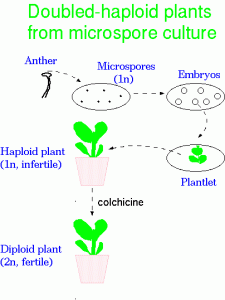
Best safe and secure cloud storage with password protection
Get Envato Elements, Prime Video, Hotstar and Netflix For Free
Best Money Earning Website 100$ Day
#1 Top ranking article submission website
Haploid plants produce homozygous lines or homozygous plants. These haploid plants are sexually sterile that’s why doubling of the chromosomes is required to produce fertile plants which are called doubled haploids. They have great importance for improving plants in agricultural applications or in plant breeding programs.
Some Agricultural applications for haploids
- Rapid generation of homozygous genotypes may be produced after chromosome doubling.
- By the methods of haploid production, time can be redued for a variety development, e.g. 10 to 6 years or less.
- Homozygous recombinant line can be developed in one generation instead of after numerous backcross generations.
- Selection for recessive traits in recombinant lines is more efficient since these are not masked by the effects of dominant alleles.
- In case of polyploidy, it is very useful by haploid induction to work at a lower ploidy level.
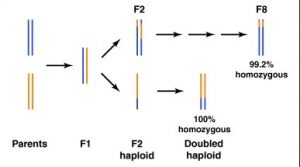
Pure homozygous line development
Methods of Haploid Production
There are two way for the production of haploid plants. They are: (1) In Vivo and (2) In Vitro. The process of apomixis or parthenogenesis is responsible for producing spontaneous natural haploids. Many techniques are followed both by in vivo and in vitro methods for haploid production. In vitro techniques are more applicable for much haploid production.
In Vivo Techniques to produce Haploids :
1. Androgenesis: In the process of androgenesis, haploid plants are mainly derived from male gamete. Development of a haploid plant from an egg cell containing male nucleus is referred to as androgenesis. Before fertilization this egg nucleus has to be inactivated or eliminated for successful haploid production in vivo techniques.
2. Gynogenesis: A haploid plant can be produced from an unfertilized egg cell as a result of delayed pollination. e.g. cross between Solanum tuberosum and Solanum phureja produced diploid potatoes.
3. Distant hybridization: Haploid hybrids can be produced by elimination. In this process, one of the parental genomes have to be eliminated to produce haploid hybrids. Distant hybridization may be continued by inter-specific or inter-generic crosses. Gersenson (1928) obtained 7 haploids out of 35 offspring by the crossing between Solanum nigrum and Solanum luteum.
4. Parthenogenesis : In plants, parthenogenesis is a component process of apomixis. Haploids may be developed from an unfertilized egg cell. In this case, no fertilization is needed.
5. Apogamy: In apogamy, haploids may be developed from other cells of the mega-gametophyte.
6. Semigamy: The nucleus of the egg-cell and the generative nucleus of the germinated pollen grains divide independently, resulting in a haploid chimera.
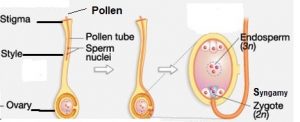
7. Shocks with high or low temperatures : Haploid plants may also be produced by applying high or low temperature. Blakesle et al (1927) got haploid plant by the application of high and low temperature (40 – 45°C).
8. Irradiation with X-rays or UV light: For producing haploids, x-rays or ultra violate rays may be used to induce chromosomal breakage and their subsequent elimination. Arenberger (1948) got haploid Antirrhinum majus and non-irradiated Antirrhinum majus.
9. Chromosome elimination : Chromosome elimination occurs in some intergeneric and interspecific crosses to produce haploids. e.g. cross between Hordeum vulgare and H. bulbosum. The process of chromosome elimination is briefly described below.
Production of Haploids by Chromosome Elimination
There are numerous examples of haploid production primarily achieved by wide crosses and embryo culture by chromosome elimination technique. e. g. barley, wheat etc.
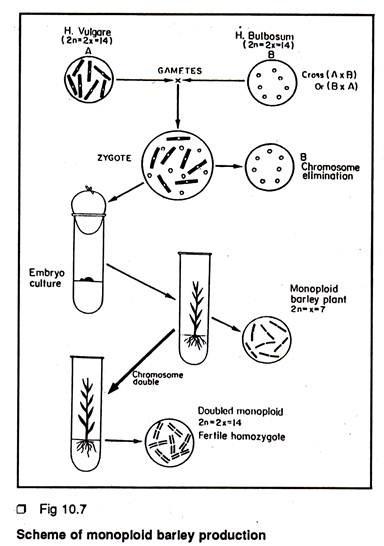
The barley example: The latest most important process in breeding methods of barley has been the recovery of high frequencies of doubled haploids (DH) i.e. homozygous lines in a single generation. Bulbosum method is more efficient than microspore culture in producing haploid barley. This was to be first reported in the early 1970s. In this method, haploid plantlets of Hordeum vulgare with seven chromosomes are produced as a result of gradual elimination of H. bulbosum chromosomes. This is achieved by an interspecific cross between barley (Hordeum vulgare ; 2n = 2x = 14, female) x Hordeum bulbosum (wild relative; 2n = 2x = 14, male). The method was started with the fertilization of Hordeum vulgare by Hordeum bulbosum followed by complete elimination of the H. bulbosum genome.
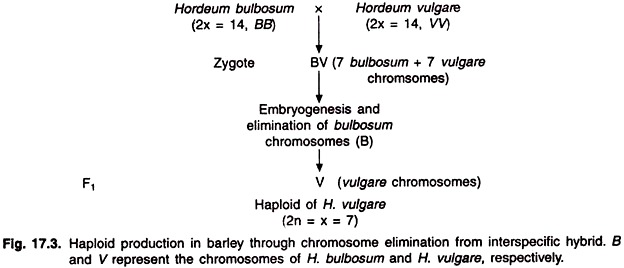
In Vitro Techniques to Produce Haploids
1. Anther culture: Most research has been carried out on isolated anthers which has been isolated on to solid or on liquid nutrient media
2. Pollen grain culture: This is less used technique due to technical problems
3. Inflorescences: Useful with grasses and other plant species which have small flowers, e.g. Hordeum
4. Embryo culture: Hordeum vulgare is crossed with H. bulbosum. Soon after fertilization, the chromosome of H. bulbosum are eliminated. Haploid embryo of H. vulgare is produced with no endosperm and without embryo culture this embryo would abort.Another example is crossing between Triticum aestivum and H. bulbosum which resulted in the production of a haploid Triticum aestivum embryo.
5. Pseudo-fertilization: Hess and Wagner (1974) pollinated Mimulus luteus in vitro with alien pollen of Torenia fournieri; by prickle pollination a haploid cell of Mimulus developed into a haploid plant.
6. Development of unfertilized ovules without pseudo-pollination: The main advantage of ovule culture appears to be that the majority of regenerants are green and are more genetically stable, e.g. rice, wheat, maize, Hordeum vulgare, etc.
7. Gametophytic irradiation and ovary culture: In Petunia, the in vitro ovary culture of plants pollinated with irradiated pollen is so far the most efficient techniques for haploid production. The irradiated pollen acts not only in stimulating gynogenesis but also takes part in fertilization.
Significance of Haploid Production
- Haploid induction followed by chromosome doubling, homozygosity is achieved in the quickest possible time that can be able to make genetic and breeding research easier.
- As a result of homozygosity, the production of pure F1 hybrid possible. The F1 population should in principle be as homozygous as possible.
- When working with plants that are normally polyploid, it is very useful by haploid induction to work at a lower ploidy level.
- Monoploids have the advantage for the mutation breeder that the recessive mutations (A to a) are immediately detectable. This is not the case with a diploid which mutates from AA to Aa; self pollination of Aa gives rise to only one in four of the double recessive mutants.
- In Asparagus officinalis, exclusively male plants could be obtained by haploid induction followed by chromosome doubling. In Asparagus , male plants are more productive and yield earlier in the season than the female plants.
- Female plants re designated by XX and males by XY. By crossing XX and XY 50% female and 50% male plants are obtained. If haploids are produced from anthers of male plants these will either X or Y. Chromosome doubling of Y result in super male plants YY which can subsequently be vegetatively propagated. If XX plant is crossed with YY then only males XY plant will result.
- When homozygotes are artificially made into diploids in vivo with colchicine, problems may arise (chimeras) which are not usually found in vitro. In vitro haploids often spontaneously giving rise to homozygotes directly.
- It is much better to work with haploid protoplasts rather than diploid ones for somatic hybridization. Fusion of two haploid protoplasts result in a diploid while the fusion of two diploids results in a tetraploid.
Most Useful Applications of Haploid Plants
1. Hybrid Development: For obtaining complete homozygosity from diploidisation, the traits can easily can be fixed for further breeding programme for hybrid production.
2. Pure Homozygous Line Development: In plant breeding, the pure homozygous line can be obtained through selfing for 6-7 generations. But this long time can be reduced to few months or a year by using the in vitro techniques (anther/pollen culture) to produce haploids. These pure homozygous lines are mainly used for breeding as well as genetic research purpose.
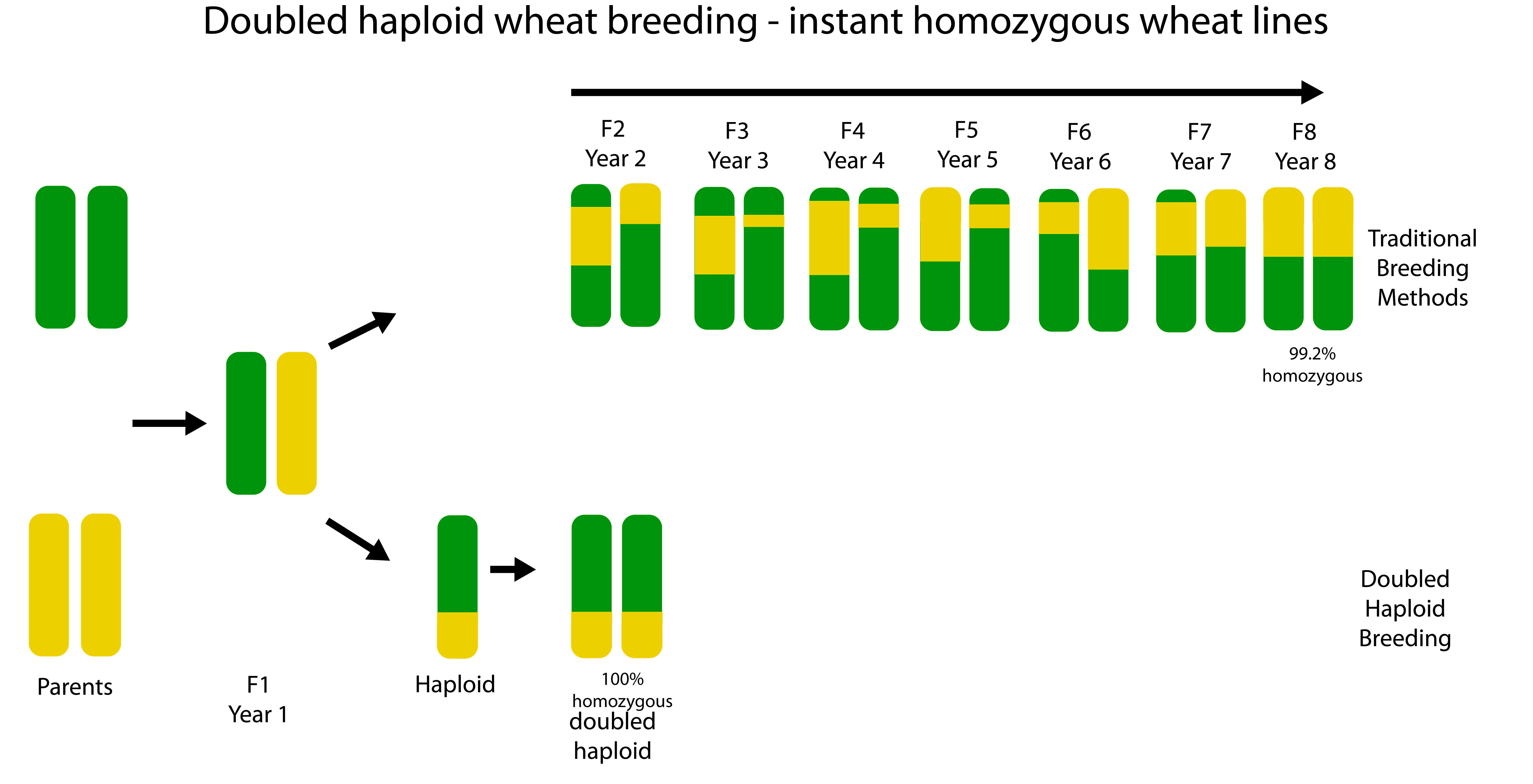
3. Early Release of varieties: As the homozygous line can be produced relatively in less time so new hybrid varieties can also be obtained in less time by applying this techniques.
4. Hybrid Sorting: Haploid breeding involves the hybrid sorting and it is considered superior to pedigree and bulk method. Produced haploids from anther culture give the advantage to select different superior gametes which can be used for haploid breeding.
5. Induction of Mutagenesis: For the induction of mutations and studying mutation effect, different haploid cell culture is very useful. This method is used to recover the masking effect of presence of dominant gene.
6. Genetic Variability Induction: Genetic variability may be induced by introducing the different foreign genes through different transformation procedure. These type of transgenic haploids can be used in breeding programme.
7. Exclusive Male Plant Generation: Haploid plants are produced from anthers of male (XY) plants and by the process chromosome doubling the Y chromosome containing plant will produce super male plant (YY).
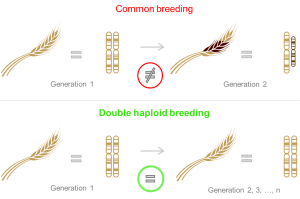
8. Disease Resistant Variety Development: Haploid production can be used for the introduction of di Disease resistance genes may be introduced into cultivars in the method of haploid production.
9. Salt Tolerant Variety Development: Salt tolerant breeding lines can also be developed by this techniques.
10. Aneuploid Development: For producing aneuploids like monosomies in wheat, trisomies in potato haploid plants can be used. In tobacco nullisomics were derived from haploid plants which are obtained from monosomies.
Written by
Tubaia Zannat Juthi, B.S. (Hons), Department of Botany, University of Dhaka
Best safe and secure cloud storage with password protection
Get Envato Elements, Prime Video, Hotstar and Netflix For Free
 Plantlet The Blogging Platform of Department of Botany, University of Dhaka
Plantlet The Blogging Platform of Department of Botany, University of Dhaka




